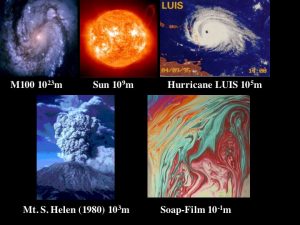Introduction to Turbulence
What is Turbulence?
Turbulence is like pornography. It is hard to define but if you see it, you recognize it immediately.
– G.K. Vallis (1999)

Turbulence is ubiquitous in nature and encompasses phenomena taking place over an extremely wide range of scales from a few millimiters to thousands or hundred of thousands kilmometers, from laboratory to galaxies.
Although the term turbulence is often used to denote very irregular motions taking place in strongly nonlinear systems, fluid turbulence has a more precise meaning being the state of motion of a fluid which is characterized by chaotic, stochastic changes in both its spatial and temporal properties. Fully developed turbulence establishes when the Reynolds number (i.e the ratio between the nonlinear and linear — dissipative — terms of the Navier-Stokes equation, describing fluid motion) becomes very high. In such a condition a nonlinear cascade of energy takes place from the scale where motion is excited (the forcing scale, which is typically large) to that where energy is dissipated (at a molecular level), and this inertial range of scales is characterized by nontrivial scale invariance properties. In particular the probability of observing large fluctuations of velocity increments (v(x+r)-v(x)) over a scale r becomes higher and higher as the scale r decreases. This is the intermittency of turbulence which stands still at the frontiers of our understanding, and links to the presence of anomalous scaling laws in the statistics of the velocity field. The only hope to theoretically cope with turbulence is, from a physicists point of view, to assess the universtality of such scaling laws, which would imply that the possibility to understand them should be hidden in Navier-Stokes equations. However, at a mathematical level turbulence, actually the Navier-Stokes equations, constitutes a –literally speaking– million dollar problem being one of the millenium problems at the Clay Mathematics Institute.

